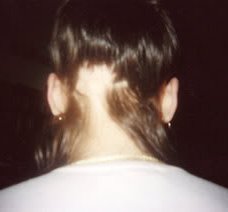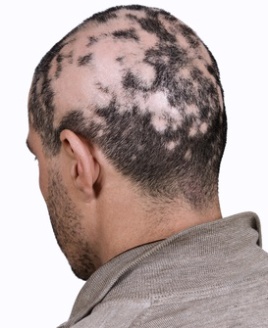Are you interested in an alopecia areata cure? We’ll tell you what causes alopecia areata and we’ll tell you about the most effective alopecia remedies available. Keep in mind the fact that there are many different types of alopecia (alopecia is just a medical term meaning hair loss) and sometimes the best treatment depends on the type of alopecia you are experiencing. If you have questions about what’s causing your hair loss or the best treatment for you, we recommend consulting a dermatologist, a doctor that specializes in treating disorders of the skin, which includes things that cause hair loss.
Alopecia Areata

Alopecia areata is a common cause of hair loss in both men and women, second only to androgenetic alopecia (also known as hereditary baldness). According to the National Alopecia Areata Foundation, more than 6.6 million people in the U.S. alone currently have or will develop alopecia areata at some point during their lifetimes.
Mild alopecia areata causes patchy hair loss. In more severe cases, alopecia areata can cause complete baldness (alopecia totalis). It can cause hair loss on other parts of the body, as well, not just on the head.
Alopecia remains a bit of a mystery but it is believed to be caused by an autoimmune disorder. As with other autoimmune disorders, the immune system goes into overdrive and attacks part of the body as if it is a foreign invader. In people with alopecia areata, the immune system attacks the hair follicles, causing hair loss. Since the hair follicles are not destroyed by the condition, hair can regrow. Sometimes it regrows on its own, while other times treatment is required.
Alopecia areata affects both men and women. It can begin at any age, although onset often begins in childhood. Despite the fact that alopecia areata is caused by an autoimmune disease, people with the condition are often otherwise in good health and do not appear ill.
Alopecia Remedies

Alopecia areata and other types of alopecia are often treated with a topical medication called minoxidil. Minoxidil is the only medication approved by the Food and Drug Administration for the treatment of hair loss in both men and women. A prescription was required in the past but minoxidil is now available over the counter. According to the National Alopecia Areata Foundation, minoxidil is more effective when a person has not lost all of the hair on their head. Sometimes doctors recommend applying cortisone cream 30 minutes after applying minoxidil, which increases the effectiveness of the medication.
Sometimes alopecia areata is treated with cortisone, which is injected into the affected areas. Multiple injections are given and the treatment is usually repeated monthly. Less commonly, cortisone pills are prescribed, but these can cause unpleasant side effects, especially if taken for long periods of time. For that reason, other forms of treatment are typically preferred.
There is another medication sometimes prescribed the treat hair loss in men called finasteride. Women cannot take finasteride due to the risk of severe birth defects, however. Because finasteride carries a much greater risk of side effects than minoxidil, it’s usually not the first treatment tried for hair loss even in men. Finasteride is only available by prescription.
Surgical treatments for hair loss, like hair transplantation or scalp reduction surgery (a procedure in which the bald part of the scalp is removed and the hair-bearing parts of the scalp brought together), can be useful for other forms of alopecia but may be less successful as an alopecia areata cure. The autoimmune disease may simply attack additional hair follicles and cause additional hair loss.
Some people with alopecia totalis prefer to wear a wig rather than treat their hair loss. Some prefer to cover their heads with a hat or headscarf. Some decide they are comfortable being bald.
Whether or not to seek treatment for alopecia areata is a personal matter. If you are considering treating your hair loss, we recommend considering all your options, including the advantages and disadvantages of each. Don’t hesitate to discuss treatment options with your doctor.
Top Recommended Alopecia Areata Cure
Our preferred treatment for alopecia areata is Rogaine, a topical medication containing minoxidil. It’s easy to use and available without a prescription. If you’ve lost most or all of the hair on your head, you might want to talk with your dermatologist about whether or not using cortisone cream along with Rogaine would benefit you. To learn more and find out if Rogaine might be the alopecia areata cure you’re looking for, just follow the link.
